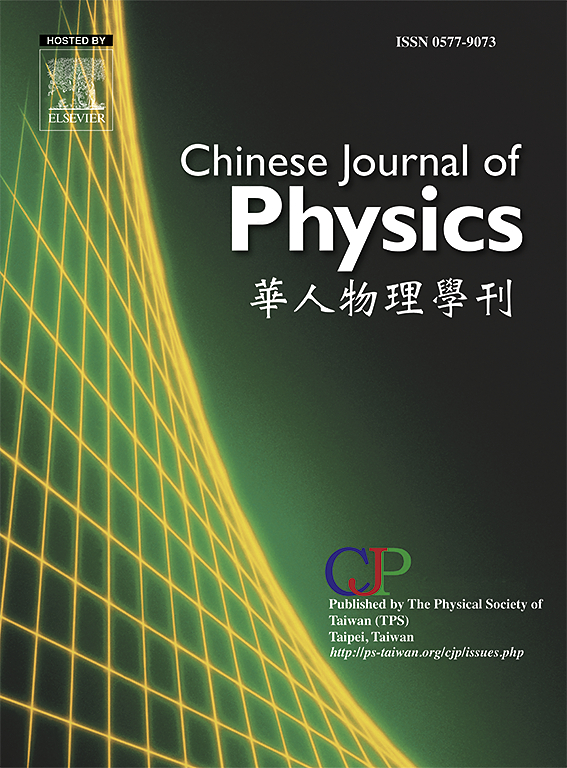First-principles study on the structural, mechanical and optoelectronic properties of the hydrogenated and fluorinated dumbbell silicene monolayers and their vertical heterostructures
IF 4.6
2区 物理与天体物理
Q1 PHYSICS, MULTIDISCIPLINARY
引用次数: 0
Abstract
Using first-principles calculations, we systematically investigate the structural, mechanical, and optoelectronic properties of hydrogenated and fluorinated dumbbell silicene (DB-SiH and DB-SiF) monolayers, as well as their vertical heterostructures. Ab initio molecular dynamics (AIMD) calculations demonstrate that both the DB-SiH and DB-SiF monolayers, along with their heterostructures, exhibit excellent structural and thermal stability. Furthermore, hydrogenation and fluorination can increase the band gap of dumbbell silicene, resulting in a direct band gap of 1.99 eV and an indirect band gap of 1.55 eV, respectively. The work function of dumbbell silicene can be effectively tuned by the chemical functionalization. The DB-SiH/DB-SiF heterostructures display direct band gap characteristics and a typical type-II band alignment. Notably, the significant charge transfer from DB-SiH to DB-SiF induces a built-in electric field at the interface of the heterostructures, which facilitates the separation of electrons and holes. Additionally, the DB-SiH/DB-SiF heterostructures exhibit enhanced visible light absorption coefficients compared to those of the individual monolayers. The interesting findings suggest that these novel structures hold valuable potential for applications in optoelectronics.

氢化和氟化哑铃型硅烯单层膜及其垂直异质结构的结构、力学和光电性能第一性原理研究
利用第一性原理计算,我们系统地研究了氢化和氟化哑铃硅烯(DB-SiH和DB-SiF)单层及其垂直异质结构的结构、力学和光电性能。从头算分子动力学(AIMD)计算表明,DB-SiH和DB-SiF单分子膜及其异质结构均具有优异的结构稳定性和热稳定性。氢化和氟化可以增加哑铃硅的带隙,直接带隙为1.99 eV,间接带隙为1.55 eV。通过化学官能化可以有效地调节哑铃型硅烯的功函数。DB-SiH/DB-SiF异质结构具有直接带隙特性和典型的ii型带对准。值得注意的是,从DB-SiH到DB-SiF的大量电荷转移在异质结构的界面处产生了一个内置电场,促进了电子和空穴的分离。此外,与单个单层相比,DB-SiH/DB-SiF异质结构表现出更高的可见光吸收系数。这些有趣的发现表明,这些新型结构在光电子学方面具有宝贵的应用潜力。
本文章由计算机程序翻译,如有差异,请以英文原文为准。
求助全文
约1分钟内获得全文
求助全文
来源期刊

Chinese Journal of Physics
物理-物理:综合
CiteScore
8.50
自引率
10.00%
发文量
361
审稿时长
44 days
期刊介绍:
The Chinese Journal of Physics publishes important advances in various branches in physics, including statistical and biophysical physics, condensed matter physics, atomic/molecular physics, optics, particle physics and nuclear physics.
The editors welcome manuscripts on:
-General Physics: Statistical and Quantum Mechanics, etc.-
Gravitation and Astrophysics-
Elementary Particles and Fields-
Nuclear Physics-
Atomic, Molecular, and Optical Physics-
Quantum Information and Quantum Computation-
Fluid Dynamics, Nonlinear Dynamics, Chaos, and Complex Networks-
Plasma and Beam Physics-
Condensed Matter: Structure, etc.-
Condensed Matter: Electronic Properties, etc.-
Polymer, Soft Matter, Biological, and Interdisciplinary Physics.
CJP publishes regular research papers, feature articles and review papers.
 求助内容:
求助内容: 应助结果提醒方式:
应助结果提醒方式:


